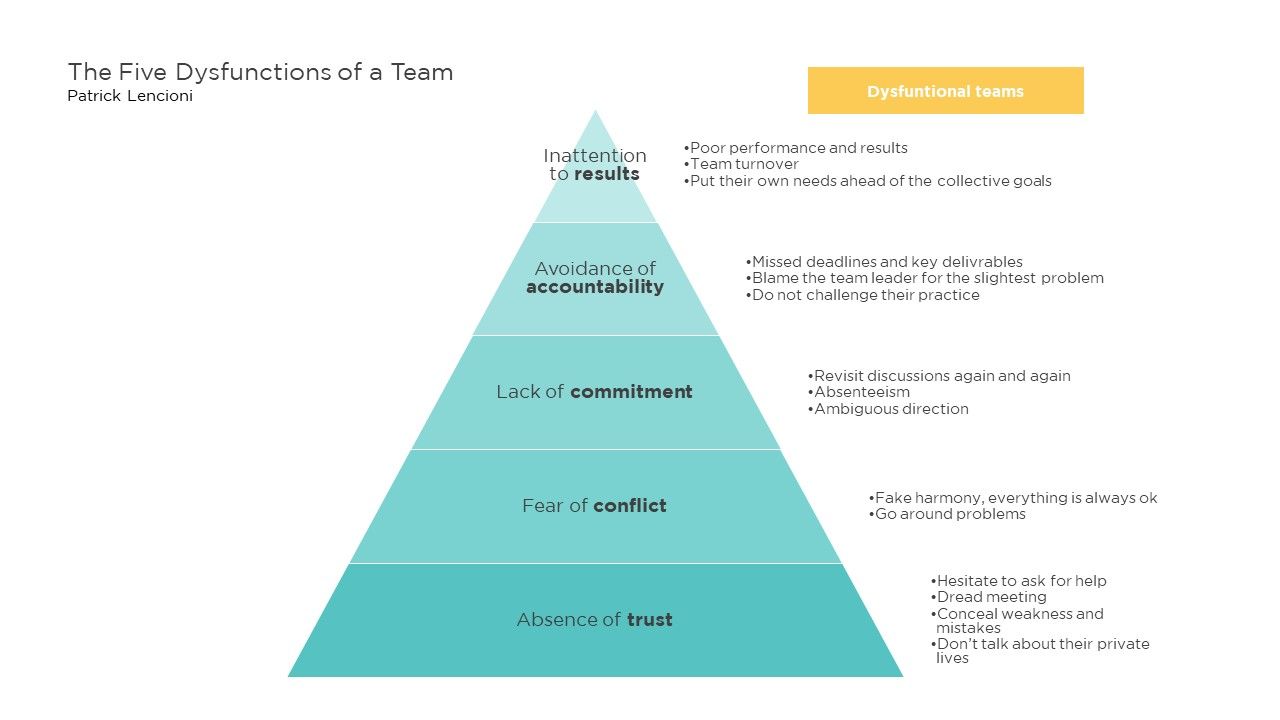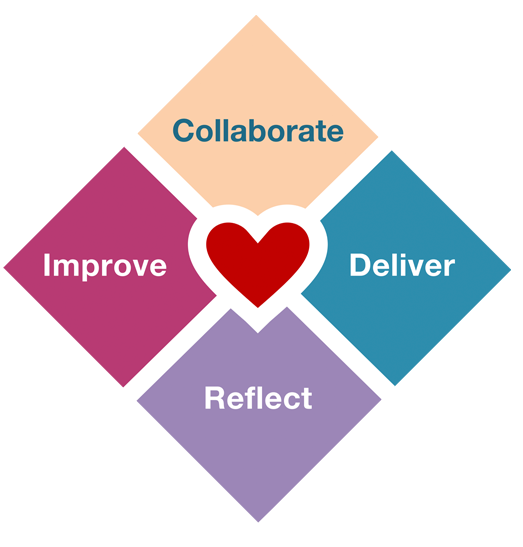The book
With his bestseller "The 5 dysfunctions of a team", Patrick Lencioni gives us a model of behavior analysis of team members.
The book is divided into two parts. The first stages in the form of a fable the arrival of Kathryn Petersen as CEO of the fictitious firm DecisionTech. There, she discovers a Comex made up of people with undeniable intelligence, but with worse behavior than anything she had seen before.
“ Therefore, no decision was made, the discussions were endless and uninteresting, with not a lot of real oral exchanges; and everyone seemed to be desperately waiting for each meeting to come to an end. "
Does this description remind you real life situations? The second part of Patrick Lencioni's book focuses on analyzing his model and suggests some ways to escape the cycle of team dysfunctions.
According to the author, there are 5 dysfunctions and they are interrelated: lack of confidence, fear of confrontation, lack of commitment, avoidance of accountability and inattention to results. They generate tensions, quarrels, misunderstandings and errors.
Here’s how to recognize them and treat them according to Patrick Lencioni.

The first dysfunction, at the very base of the pyramid: the lack of trust between team members.
This happens when team members are resistant to being vulnerable. This means the ability to show its weaknesses or mistakes. We recognize a team that lacks confidence when its members don’t share, or just a little, about their private life, encounter difficulties offering and asking for help or do not give each other constructive feedbacks.
A team in which there’s no trust is therefore not able to have sincere conversations, or passionate debates ... and this is the fear of confrontation.
The members seem to always agree with each other. This is actually a false harmony, meetings are often boring and important or thorny topics are carefully avoided.
Hence, the team members are not ready to give their opinions or ideas and fall into a soft consensus. So, they can’t make confident decisions and commit to implementing them: that’s what we call a lack of commitment.
We can see that kind of dysfunction in teams where decisions and discussions are questionned without clearly setting priorities and next steps.
If the team is not committed to clear decisions and does not engage its members in achieving these goals, then they develop an attitude that results in avoidance of accountability.
People do not respect deadlines, they place the responsibility on their team leader for the any problem or they do not challenge their practice.
The consequence: inattention to results. People show their own need (career, ego, recognition...) before those of the team. These people will take credit for success at the expense of the efforts of the rest of the group. The team neither learns nor evolves.
As we can see, these dysfunctions are linked to each other. If the team allows any of these dysfunctions to set in, then all the work done by the team is deteriorating.
Possible solutions
To overcome these dysfunctions, Patrick Lencioni proposes some solutions to implement. I update them with some tools used at Extia.
Generate trust
Trust must start from the leader.
“This means the leader accepts the risk of losing face in front of his team members, so that they take the same risk.”
It is also important to build a framework where vulnerability is not blamed or mocked. The leader must be vigilant on this point in order to prohibit mockeries or insidious remarks to take place in the discussions.
Then, it is possible to work on exercises that aim to get to know each other.
• Sharing personal anecdotes to encourage empathy.
Sharing a personal anecdote doesn't just happen at the coffee machine. This can become a real exercise for teams (especially those whose members do not know each other much). This can be done in a variety of ways: crossed Chinese portraits, realization of personal mindmaps...
• The team efficiency
This is a workshop whose objective is to highligh the strengths and areas for improvement of each team member. At Extia, we use the Totem game to talk about the strengths and positive contributions of each team member. Using competency maps is also a good tool to learn to recognize strengths in a team.
• Behavioral assessments
The idea is to get to know yourself, but also to share this knowledge with others.
Patrick Lencioni discusses the use of the MBTI (Myers-Briggs Type Indicator). At Extia we use the Communication Process for the same purpose.
• The 360 ° feedback
This approach should be seen as a personal development tool in order to identify your strengths and areas for improvement without any consequences. The idea is to go and ask for feedback from colleagues, collaborators, managers, customers: in fact, everyone with whom we work.
• The team building
Again, the goal is to spend time together in order to get to know each other better, especially in a setting that may be outside the professional sphere. Teambuilding allows you to have a common experience that unites the team. The challenge is to carry out activities (sports, creative or others) that could be debriefed so as to highlight the importance of teamwork.
Avoiding false harmony
The leader's position here is quite subtle, because as Lencioni points out, he or she must be able to frame the discussions, but without adopting a paternalistic posture that would overprotect the team. To do this, the author recommends taking a step back during conflicts by listening in order to allow the team to reach a natural resolution of the conflict.
Some tools to accompany passionate debates:
• Extraction
Patrick Lencioni proposes a "minor" role that can be played by one or more people in the team during meetings. These people will go and bring up the buried disagreements by exposing them until they are resolved. This role requires objectivity while being courageous and caring with the team. To practice this role, it can be interesting to use the Bono Hats method to confront points of view.
• Permission in real time
Extraction can be an awkward moment for the team and depending on the personalities, the tone can quickly rise while others will fade from the conversation. It is important to interrupt the debate to remind the team that confrontation is important and that it must be done in a healthy atmosphere.
• Behavioral profiles
Behavioral profiles (MBTI, Process Com...) are also good tools to allow team members to understand the way they communicate with each other and use the right communication levers. They can be complemented by other more specific tools such as the Thomas-Kilmann Conflict Management Tool (TKI).
Building team commitment
The leader must encourage team members to find a solution to problems, but also to meet various deadlines. To support them and ensure that everyone is committed, the leader's role is to maximize the clarity of the issues and the alignment of everyone.
• Cascading messages
At the end of each management meeting, participants take a few minutes to list the key decisions that have been made and define among themselves which elements can be communicated to the teams and which ones will remain confidential. This allows employees to have the same level of information from all managers and it helps managers to build a strong and positive image.
• Deadlines
Each decision is also accompanied by a deadline that must be communicated and respected with discipline and rigor. The synchronization of each one allows to avoid ambiguity.
• Worst case scenario
For teams that would have difficulty committing to certain decisions, Patrick Lencioni suggests doing a worst-case scenario exercise. "What if the worst happens?" allows teams to ease their fears and better understand that the impact of a bad decision is far less damaging than what they imagine.
Making teams accountable
In an accountable team, the leader is not the only source of discipline. His objective is to intervene only as a last resort to take decisions.
Patrick Lencioni discusses a few simple tools and practices that can be put in place to make each individual in the team accountable, once again avoiding ambiguous and unclear situations.
• Disclosure of objectives
Communicate on what the team must achieve by specifying the tasks and the role of each person. It is possible to use visual management tools to make this information clear.
• Evaluation of the team's progress
This evaluation should be done in a simple and regular way. In this ritual, the team members give each other feedback on the progress of the tasks or the behavior of each person. Each one can then intervene to give warning points if something is not going well.
• Collective rewards
The team can create a culture of accountability by rewarding collective rather than individual achievements. This way, all team members become active in achieving the goals.
Keeping an eye on the team's results
Finally, for this last dysfunction, the author mentions two suggestions to overcome inattention to results.
The first one is to share the team's results publicly: Patrick Lencioni suggests that teammates publicly commit to their outcome, in order to create a stronger commitment and a greater desire to succeed.
The second suggestion is to propose results-based rewards. Financial reward should not be the only motivational lever. However, according to Patrick Lencioni, setting a reward on the achievement of results has more weight than rewarding "sustained effort" because it adds importance to those objectives to be reached.

